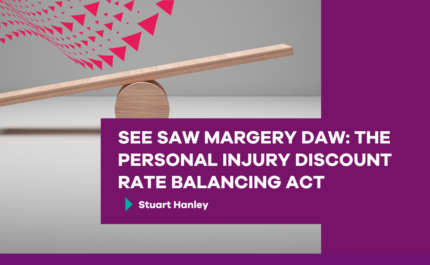
Serious injury team member and avid cyclist Mark Kilbride explores the impact of cycle lanes on making roads safer for cyclists.
The anger of many car drivers against cyclists, and cyclists against car drivers is very real. It results in anything from near misses, roadside fights to serious injury and death. This problem shows no sign of reducing. So, how can this be improved for the sake of safety and harmony on the roads? So far the idea has been to create cycle lanes, on the road and pavement.
The vast majority of examples in the UK consist of a painted line on a road that was not originally designed to have that amount of room ‘spare’. No doubt well intended, they offer little help to either motorist or cyclist. Painted lanes are cheap and allows local councils to say they are doing something to keep cyclists safe.
According to the Royal Society for the Prevention of Accidents, in 2018 17,550 cyclists were killed, seriously injured or slightly injured on the roads in the UK. 75% happen at, or near, a road junction and 75% of fatal or serious cyclist accidents occur in urban areas.
Cycling around the country, I regularly see cars, vans and trucks parked across cycle lanes. Bus stops cut across them, I see broken glass, bricks, metal and any sort of rubbish in cycle lanes. They can be too narrow, with deep set drains and randomly end or go onto the pavement for 6 ft with a hugely helpful ‘cyclists’ dismount’ sign bringing them to an abrupt halt.
The internet is littered with examples of utterly ridiculous painted lanes basically going nowhere, which must have been signed off by somebody with the council offices. Most ‘proper’ cyclists won’t even use them. They offer no real protection against a closely overtaking truck or a motorist angry at having to wait a few seconds to get back up to 30 mph having had to slow down. The busier the road, the less help the painted lines are.
In July 2020 a ‘Dutch style’ roundabout was opened in Cambridge, which gave cyclists the right of way across all entries and exists. An incident was reported in the media that an accident happened as soon as it had opened, which gave a negative impression as to its safety. However, it appears it happed the night before it was officially opened and involved a vehicle hitting a beacon and driving off. It cost £2.3 million to build that one roundabout. Perhaps at that cost it’s going to take some considerable time to convince other local councils that this is a worthwhile investment.
In Europe there has been more attention and investment in assisting traffic flow and safety. So, can the UK catch up?
Essentially, how safe people using the road are going to be is pretty much all in the design. On busier roads a physical barrier would provide the best protection, and with continuous lanes in and out of town and city centres, we might start to get there.
During the Covid lockdown, the sales of entry level bicycles went through the roof and the gradual reduction in price of e-bikes help sales of those increase significantly. The cycle to work scheme also saw a 200% increase in bicycle orders, with bike shops struggling to keep up with demand. As a consequence of this, the shares in Halfords increased by 23%. Will those bikes keep getting used or find their way to the local tip in a relatively short time? The roads were virtually dead at the time and ‘pop up’ cycle lanes were created, but a number of these have since disappeared and not replaced with anything more permanent. It’s understandable that the safer people feel, the more they will be cycling, especially with a young family. No one wants to see the momentum lost due to the lack of political will or funds.
But there are some positives
The whole issue of cyclist safety does appear to be higher up on the agenda now than it ever has been, and this comes from a place of political will, egged on no doubt by the pandemic and campaigners such as Chris Boardman, Living Streets, Cycling UK and Bike Worcester. Six leading cycling commissioners recently wrote to the Government urging them to stop wasting millions of pounds on pointless white lines on the road and demanded they commit to funding for proper cycling and walking infrastructure.
It’s going to be expensive, it’s going to take some time, but I do believe that in time the lazy, thoughtless painting of lines seen as an adequate solution (especially on the busier roads) will be seen as just a bad era for cycling and urban design. The Government has recently issued guidance to local councils warning against them creating narrow ‘advisory’ lanes on roads with heavy traffic and the creation of routes that require a lot of stop/start from cyclists. During lockdown the Government announced a £250,000,000 investment in cycles lanes across the UK. In addition, a new inspectorate, Active Travel England, will oversee the budget for England and refuse funding for local authorities who do not meet the new standard. I also anticipate some changes to the Highway Code, placing the cyclist higher up the ‘food chain’, which will influence driver behaviour.
The direction of travel seems to be going in the right direction at present and I for one hope it continues in that way. The UK has never treated cyclist’s safety seriously, but it seems to be trying to catch up to its European counsels.
The proposed actions will hopefully help both motorist and cyclist to stay safe, and perhaps, finally get along!



